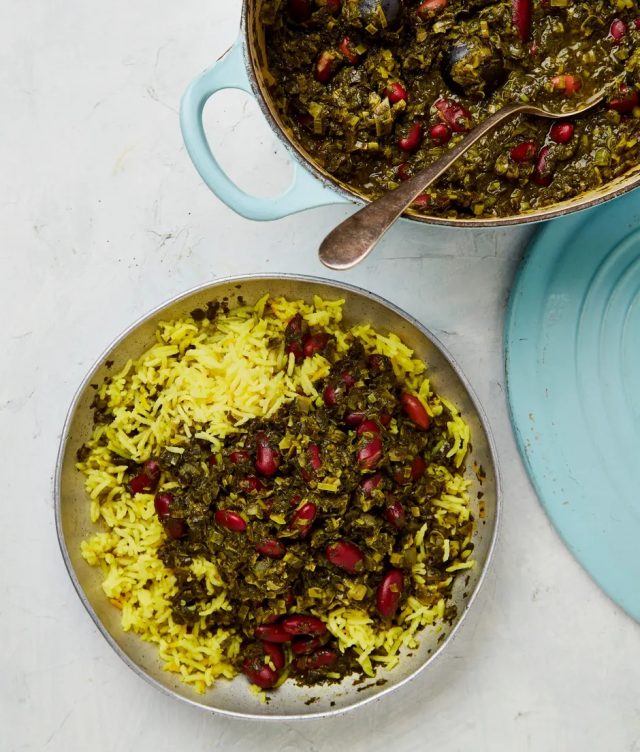theguardian– We are at the very heart of autumn now, almost time for the cast iron soup pot to come down from the shelf. There are seasonal treats, too – game birds and chestnuts, glowing red apples and figs as purple and tender as a bruise.
This week I made a dinner – a celebration of sorts – of pot roast pheasant and scarlet apples, the bird carved none too professionally, served with a soupy sauce of cider, bacon and sage.
It is good, but almost better is the soup we make from the carcass the next day, the meat stripped from the bones and simmered with onion, carrots and celery, and a bunch of thyme and bay. We threw in a handful of small brown lentils that turned the soup into a meal.
The figs, almost impossible to resist, were baked in crumbly pastry cases with onions and crème fraîche. We baked them before the pheasant went in and ate them warm, as you might a quiche Lorraine, before the bird. The two that were left worked as a lunchbox treat for the following day.
Fig and red onion tarts
There is something particularly satisfying about having a small pastry all to oneself. The pastry is better behaved for being rested in the fridge for 20 minutes before being used to line the tart tins, and less likely to shrink during baking. Take care not to spill the filling over the rim of the tarts as they will stick to the tins. Makes 6
butter 100g
plain flour 200g
egg yolk 1
water a little
For the filling:
red onions 2 large (or 3 medium)
butter 40g
figs 200g
crème fraîche 200m
egg yolk 1
You will need 6 loose-bottomed tartlet tins about 8cm wide and 3cm deep.
Make the pastry: put the flour into a food processor, add the butter and process for a minute or so until you have coarse crumbs. Add the egg yolk and enough water to bring to a firm rollable dough. (I start with 1 tbsp and add a few more drops until I have a manageable dough.)
Remove the dough from the machine, knead very briefly on a floured board, then pat it into a round, wrap in kitchen paper and refrigerate for 20 minutes.
Set the oven at 180C/gas mark 4. Peel the onions, slice them thinly into rounds, then let them cook in the butter over a moderate heat, until very soft. Stir them from time to time – they will probably take a good 20 minutes. Give them time to become glossy and slightly jammy. Remove them from the heat. Chop the figs into small pieces, then stir into the onions with the crème fraîche. Beat the egg yolk with a fork then stir into the mixture and season lightly with salt and pepper.
Lightly butter the tart tins and place them on a baking sheet. Roll the pastry out thinly and cut 6 discs roughly 15cm in diameter. Use the discs to fill the tart tins, pushing the pastry gently into the corners. Place a piece of paper in each tart case along with baking beans to prevent the pastry slipping or rising. Bake for 20 minutes, then remove the tray of tart cases from the oven, lift out the paper and beans, then return the cases to the oven for 3 or 4 minutes until dry to the touch.
It is worth carefully loosening the tart cases in their tins so they are easier to remove once filled and baked. Stir the filling, then spoon into the tarts. Bake for a further 30-35 minutes, remove them from the oven and allow to rest for 10 minutes before serving.
Roast pheasant with apples and cider
I find even the plumpest pheasant feeds just 2 people, but they become good value when you use the bones for soup. The bacon – or pancetta if you prefer – is there not only for flavour but for its fat, which pheasants tend to lack. Check the birds’ progress in the oven regularly, but I find erring on the side of under-rather an over-cooking gives a juicier result. Serves 2
pheasants 2
butter 30g
unsmoked streaky bacon rashers 6, cut into short lengths, or small cubes of pancetta
onions 2, medium
dry cider 250ml
bay leaves 2
sage leaves 3 or 4
apples 4-6, small and tart
Preheat the oven to 160C/gas mark 3. Season the pheasants with salt and black pepper. Peel and roughly chop the onions. Melt the butter in a deep casserole or roasting dish over a moderate heat, add the bacon or pancetta and sizzle for a couple of minutes until the fat is golden, then add the onions and continue until they are soft and pale gold. Remove from the pan and set aside.
Introduce the pheasants to the pan, letting them colour on all sides, turning them in the fat as necessary, until golden. Lift them out and set aside with the bacon.
Pour the cider into the pan and bring to the boil, stirring in the juices that have caramelised on the bottom, then return the bacon, onions, pheasants and any escaped cooking juices to the pan.
Score each apple around its middle with a knife – it will stop them splitting in the oven. Add the bay, sage leaves and apples to the pan, then cover with a lid, place in the oven and leave to roast for about 50 minutes.
Test for doneness – the meat should be juicy, very slightly pink inside and the skin should be amber gold. Remove from the oven and set aside, still covered, to rest for 10 minutes.
Serve the birds with the apples and pan juices. The aromatics in the tin should have the deeply appley spirit of autumn.







